In this HD video and article coverage, we load Hypertech Max Energy Power Programmer tuning into the Jeep 4.0L XJ Cherokee and our Dodge Ram 4WD 3500 Cummins 5.9L pickup. See why we picked this programming and get the results from our testing.
Note: The market is rife with engine management software and “chip” programmers. We met with Hypertech staff at the 2013 SEMA MPMC Trade Conference and were impressed with the products and research that go into the Hypertech programmer tuning. The discussion continued for months as we narrowed down our tuning objectives for the magazine’s 1999 Jeep XJ Cherokee 4.0L inline six and the 2005 Dodge Ram 3500 4WD with Cummins 5.9L diesel power. The results were comprehensive tests and evaluations of the Hypertech Max Energy Power Programmers for each of these applications in real world use.
The Jeep 4.0L inline six has a tremendous track record for dependability, adequate power and somewhat reasonable fuel efficiency. A seven-main bearing design, OHV pushrod engine, its roots date to the 1964 AMC 199/232 six! Rugged, robust and capable of delivering 250K miles or more of service from reasonable care, these engines are well respected and built a Cherokee and YJ/TJ Wrangler reputation that began with the 1987 4.0L XJ Cherokee.
If this engine has a shortcoming, it’s the short stroke and overbore that drove the torque peak rpm upward. The predecessor 4.2L/258 inline six was famous for its diesel-like torque rise that took the torque peak rpm down to a remarkable 1600-2000, depending on the year model.
First exposure to the 4.0L in a 1987 XJ Cherokee model revealed this shortfall, and this bore/stroke configuration began a faster-spinning torque peak trend. Depending upon the model year, the 4.0L engine’s peak torque point ranged from 3000-4000 rpm! The stock 1999 model XJ Cherokee 4.0L has approximately 225 ft-lbs torque at the somewhat “better” 3000 rpm.


The 1999 Jeep XJ Cherokee features a 6-inch long arm lift for 33″ BFG tires (left), ARB Lockers, a Warn front winch with ARB bumper, Warn rear bumper/tire carrier and more! This is 600 pounds of “stuff” that takes the breath right out of a stock tuned engine! At right is our vintage XR350R on the bike trailer—behind the XJ Cherokee!
Why all of this emphasis on torque peak instead of the more tauted horsepower peak? Because engine fuel efficiency and sustained power reflect the torque peak. When the ’99 XJ Cherokee cruises on the highway in overdrive at 2000-2100 rpm, it is running at an inefficient rpm for both gas mileage and “pickup”. Regardless of adequate horsepower at that speed, the engine is still way below both its peak horsepower—and torque.
Our target with the Hypertech Max Energy Power Programmer is pragmatic: peak efficiency, improved fuel mileage and higher manifold vacuum at cruise rpm. Others may pursue a horsepower gain, we don’t. Manifold vacuum is another indicator of fuel efficiency and directly relates to engine design, spark timing advance, fuel flow and camshaft profile.
The Hypertech Max Energy tuner was our choice because it provides the best torque at cruise rpm—2000-2400. This performance increase, in our case programmed for regular grade fuel, delivers peak torque at 2000 rpm! Though not a grandiose peak gain (12 ft-lbs, see the dynamometer results), this is significant in that the engine’s torque peak speed has dropped 1000 rpm.
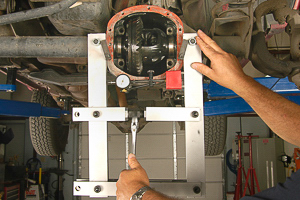

Our 4.10 axle gearing (left) with 33″ tires is an exact speedometer match-up for the factory 3.55:1 axles and stock tire diameter. We’re testing, essentially, a stock profile gearing with the added weight of 600 pounds in bumpers, a winch and oversized tires on a 6″ long-arm suspension lift. Gearing/tires determine the cruise speed engine rpm, and our test vehicle is an optimal testbed for stock or lightly modified vehicles. At right is a Tony Hewes 4.6L stroker inline six long block, the ultimate torque remedy for Jeep 4.0L engines. The Hypertech programmer would likely enhance a stroker six configuration, as these strokers still rely on the OE Jeep PCM tuning…That’s worth a test!
The Hypertech tuning is a gain in both horsepower and torque, across the rpm range, even when set for regular grade fuel. Greater gains are possible on the premium fuel setting, but in the real world, we’d rather save the 30 cents per gallon price for that tuning. Our test is optimal for those with a multipurpose XJ Cherokee, Grand Cherokee or Wrangler with a 4.0L inline six.
As for our test results, the immediately apparent gain is throttle response and a totally new feel to the engine. Short of a stroker crankshaft upgrade, this is the best and most noticeable torque gain possible for the 4.0L inline six! The engine performs altogether differently, with instant throttle response from 1200 rpm (throttle tip-in) to redline. In the practical range of 1200-3400 rpm, the tuning is an obvious boon. At 2000-2200 rpm cruise, the engine response is dramatically better than stock, and the torque peak at this speed provides exceptional throttle response. The added 600 pounds of upgrades and accessories have been clearly offset by this tuning. When in the right gear, the Jeep® Cherokee now has exceptionally smooth pulling power across the rpm range under hard acceleration.
Note: The change is so dramatic that we wonder why Chrysler/Jeep® overlooked this level of tuning. Hypertech’s programming is 50-State legal and clearly delivers both a performance and fuel efficiency gain since the torque peak has dropped to 2000 rpm…Congratulations, Hypertech!
The test vehicle has a Borla header and Random Technology low-restriction catalytic converter, plus a smooth flowing exhaust system, with no other modifications. As we discovered with the catalytic converter change, there are significant restrictions in the factory exhaust flow. The Hypertech spark/fuel tuning takes full advantage of these exhaust modifications.
Installed some time ago, the Random Technology cat made a significant difference and brought out the benefits of the Borla header. Similarly, the Hypertech Max Energy tuning delivers another “leap” in noticeable performance and smoother acceleration—especially at real world rpm and cruise speeds!
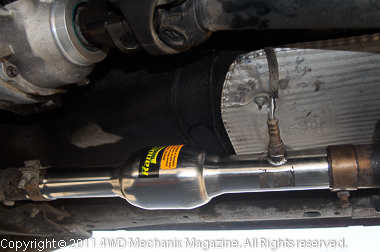
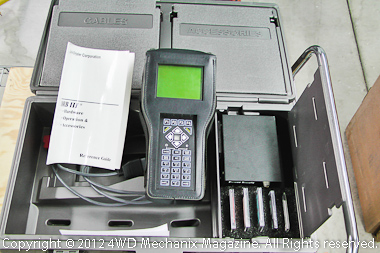
At left is Random Technology high performance cat with OEM #2 oxygen sensor in place. Right, the DRB-III scan tool is factory for both the ’99 Jeep Cherokee and 2005 Dodge Ram. The Hypertech Max Energy programmer will read codes, erase DTCs and even calibrate the Dodge Ram’s speedometer (axle differential tone ring driven) without the need for a DRB-III tool!
For Hypertech to increase performance at this critical rpm is truly an accomplishment. Did this tuning bump up fuel efficiency, or make the engine breathe easier, or eliminate the time-honored “lugging” sensation of a 4.0L at cruise speeds? Yes, the Hypertech Max Energy tuning accomplishes each of these feats!
Note: If you’re weighing a 4.6L stroker buildup versus the Hypertech 50-State legal (California E.O. number included) Max Energy Power Programmer, the 4.6L is still the torque monster and deal breaker. However, we would like to try this Hypertech tuning program on a 4.6L stroker like the Tony Hewes build for Brent H.’s 1998 XJ Cherokee. Hypertech unleashes so much performance with its tuning formulas that a 4.6L stroker upgrade might really “come alive” with this programming! Short of the stroker buildup, this tuner is the most substantial performance upgrade available for a stock 4.0L engine—even more so with our exhaust modifications!
Here is a snapshot of the Hypertech kit that we tested, designed and tuned for the 1996-99 Jeep® 4.0L inline six:
1996-99 Jeep Cherokee, Grand Cherokee and Wrangler 4.0L L6 G as Max Energy Power Programmer – Part #52500
Performance Gains
Premium Octane: +13HP +19TQ
Regular Octane: +10HP +14TQ
Emissions Certifications
•CARB E.O. D-260-15
Adjustable Features
•Top Speed Limiter 25 – 75 MPH in 5 MPH increments, 81 to 255 MPH to match speed rated tires
•Rev Limit -500 to +500 RPM
•Return Back To Stock
•DTCs Read and Clear
•Internet Updateable
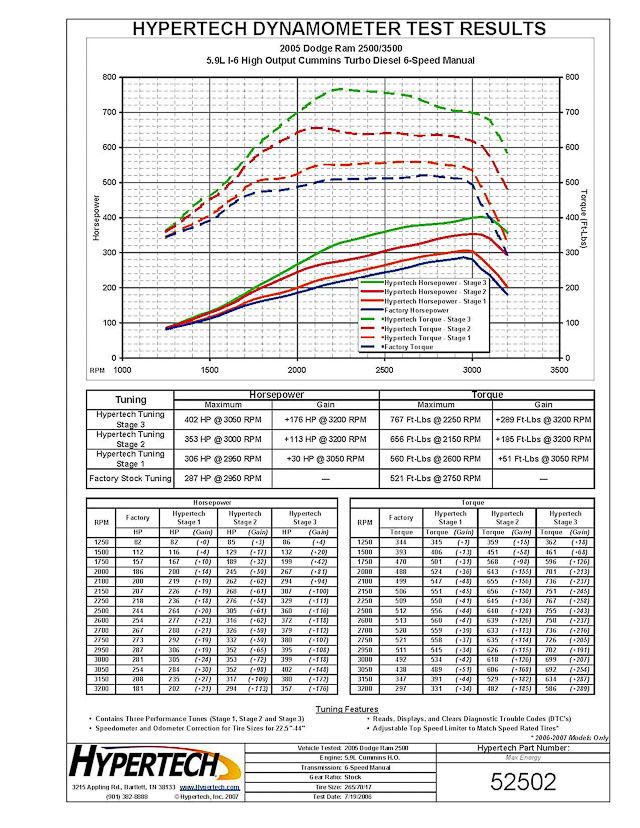

These are the dynamometer test results conducted by Hypertech for the Jeep® 4.0L inline six ‘Max Energy’ power programmer. Click here for the PDF download to enjoy a close-up view!
Hypertech Max Energy Power Programmer for the Dodge Ram 4WD 3500 Cummins 5.9L Diesel with Automatic Transmission
The magazine’s multipurpose use 2005 Dodge Ram 3500 4WD pickup truck with Cummins turbo-diesel power is a workhorse! Purchased new and transformed in 2011 with aftermarket upgrades, the truck has become a fully functional head turner—and that’s satisfying!
In the process, however, we have added 1200 pounds of accessories and extra fuel: bumpers, M12000 winch, lift kit, oversized wheels and tires, a 75-gallon steel auxiliary fuel tank and more! The truck’s once conservative frontal area is now a stout, “pushing a billboard down the road” stance, great looking, for sure, but not much for aerodynamics or fuel efficiency.
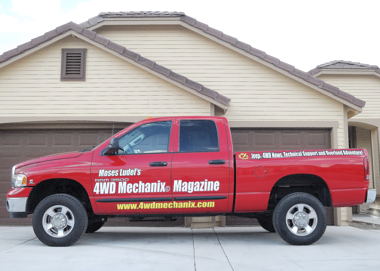
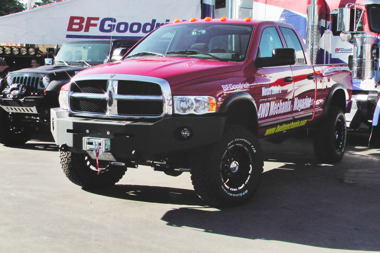
At left is the Dodge Ram 3500 Quad-Cab 4WD with Cummins power. The truck was in totally stock form from purchase in October 2004 until 2011. At right is the transformed truck on display at the BFGoodrich® booth during the 2011 Off-Road Expo. The truck made another guest appearance with BFG at the 2013 Off-Road Expo! Many know this truck from annual trips to the Moab Jeep Safari and our transportation to the SEMA Show.
Added weight alone makes the truck a hauler, the equivalent of at least a tent trailer in tow. We compensated for the load with a 4.56 gearing change that did offset the weight but also drove the engine rpm higher at each road speed. The oversized tires correction from 3.73 OE gearing and stock tires to the current 35″ tires is 4.10 gears. We opted for 4.56 gears because of the added weight and our anticipated trailer towing.
The fuel mileage dropped significantly with all of the modifications. 35″ tires and stock gearing really damaged fuel efficiency, as the overdriving effect took the diesel rpm down too far at cruise speed. When stone stock with 32″ tires, the truck delivered as much as 25 mpg unloaded (consistently 23-24 mpg on-highway without a load). Showroom stock curb weight was 7800 pounds; current curb weight with full tanks of fuel is closer to 9100 pounds! Pulling a trailer with the 35″ oversized tires and stock 3.73 gearing really dropped the fuel mileage…

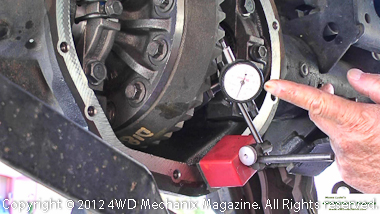
At left is Dodge Ram 3500 getting fitted with 4.56:1 gearing, the rear AAM 11.5″ axle. The AAM 9.25″ front axle gets matching gearing at right.
A change to 4.56 gearing helped performance dramatically, even with stock engine tuning and a stock exhaust system. However, the new gearing also lowered the fuel-efficiency road speed from an historic 69 mph to a peak speed of 65 mph. Any road speed beyond 65 mph showed an immediate and proportionate drop in fuel efficiency.
The original “sweet spot” for utilizing maximum torque and peak fuel efficiency was 1600-1900 rpm. This rpm window changed with the added vehicle weight. The load demanded more horsepower, which drove rpm up, and fuel efficiency came down. 1980-2000 rpm became the new sweet spot, with a road speed of 65 mph at 1987 rpm.
Our attaction to the Hypertech Max Energy Power Programmer aimed at maximizing fuel efficiency and easing engine load, fatigue and turbocharger boost. This takes exhaust gas temperatures (EGT) into consideration. On a diesel engine, “EGT” is directly related to how much fuel gets shoved into the engine under load. With towing planned, EGT is a genuine concern.
Hypertech notes that its diesel programs are each “tow friendly”. When diesel EGT crawls above 1300-1350 degrees F (turbine inlet temperature), there’s room for concern. By 1400-degrees F, the engine is stressed. So, EGT friendly is essential for us, we want this truck to clock at least 500K miles over its service life, with only reasonable wear, routine maintenance and customary repairs. (The Cummins 5.9L ISB 24-valve turbo-diesel can potentially handle this, though we expect the 48RE transmission to need attention long before the half-million mile mark, even with conscientious service and respectful driving techniques.) To accomplish this means keeping EGT below the piston-melting threshold!
Note: We intend to install a pyrometer before towing with this truck. A safe approach with any diesel engine is to drive by the pyrometer, and this also saves a lot of fuel. Again, the more fuel you stuff into the engine under load, the hotter it burns; keeping EGT lower burns the least amount of fuel for better mileage. Currently, we rely on Hypertech’s findings and use the gears to offset periods of extended loading! This is common sense for any level of diesel tuning.
Another objective for our truck was to improve fuel efficiency at 69-70 mph. The choice to use the 4.56 gears stemmed from no ratio available between 4.10 and 4.56 at the time. (Now AAM is offering a 4.44 gearset, which would likely have been our gearing choice.) We drive Interstate 80 regularly with its 70-75 mph posted speed. 65 mph is acceptable in the slow lane, but without a trailer in tow, that’s just too slow when driving from the Reno Area to Wendover en route to Moab, Utah for the Jeep Safari!
Researching the Hypertech Max Energy tuning revealed just what we wanted. Hypertech encouraged setting the programming for the maximum gain: ‘Stage 3’. The dynamometer results revealed a very useful fact: A 5.9L diesel with Stage 3 tuning moves the torque peak rpm from the factory claimed 1600 rpm to 2100 rpm—just the right engine speed to put the truck at 69-70 mph on 35″ tires with the 48RE transmission in overdrive!
Though it remained to be tested whether that higher torque rpm would actually bring improved fuel efficiency at 69-70 mph, the dyne results were certainly promising. This factor alone helped us decide that the Hypertech Max Energy Power Programmer needed testing!
Installation of a Hypertech programmer is very user friendly. There are additional functions like DTC code reading and clearing. For the Dodge truck, you get the bonus feature of speedometer correction…We borrowed a DRBIII scan tool from friends at OTC/Miller SPX to calibrate the speedometer. The AAM tone ring being strictly concerned about tire diameter, the calibrator built into the Hypertech tuner serves equally well.
Note: If there is any difference around speedometer calibration, it would be Hypertech limiting tire diameter choices to 0.25″ diameter increments. The DRBIII scan tool asks strictly for a “revolutions per mile” for the tire, which allows slightly finer setting. This is splitting hairs when considering the $6000 price tag on a DRBIII scan tool—if you can still find a new DRBIII tool! The dealership-grade DRBIII scan tool is rapidly being phased out by software emulators.
Like the ’96-’99 Jeep® 4.0L kit that we installed in the Cherokee, the 2003-2005 Dodge Ram 5.9L diesel programmer installation is through an OBD-II interface plug. Loading of the program is straightforward. In the HD video, you will see how easy this installation can be. Better yet, the kit stores the OE programming in the programmer; that stock program remains available in the event you need dealership service or OE tuning for a particular service procedure. You can even reload the stock program into the current vehicle and subsequently load the Hypertech program into another vehicle…However, you cannot randomly load the programmer software into more than one vehicle at a time.
Our installation was just in time for the perfect test: a 1200 mile round trip from the Reno, Nevada area to the 2013 SEMA Show by way of a Southern California extension to the trip. With very few miles on the installation, enough to confirm a correct software choice, we put the “Stage 3” (maximum torque and performance) tuning to the test. The truck left home with luggage, 110 gallons of fuel on board, driver and passenger, tipping the scale around 9500 pounds. (Weight went down some during the trip, the passenger caught a plane home from Southern California, the fuel dropped steadily without the need for a fill-up.)
Immediately apparent was the “freer”, less constrained feel to the engine during rollouts from a stop and in the cruise speed zone. There was U.S. Highway 95, Nevada 360, U.S. 6 over Montgomery Pass and U.S. 395 down the Owens Valley/Mojave Desert to play with speeds and fuel efficiency. Again, the aim was to bump speed to 69-plus mph unless posted 65 mph or lower. Could the engine sustain good fuel efficiency at the “new” torque peak rpm of 2100, which meant 69-70 mph in the 48RE automatic’s overdrive gear (0.69:1)?
The tests were real world. Very few stretches of the trip were without a grade, up or down. For accuracy, when we did have the opportunity to “cruise” with the cruise control set to 69 mph on a flat stretch, the mileage calculation would begin all over. The 6-percent grades on I-15 (Cajon Pass and Barstow to ‘Vegas), Montgomery Pass and all, mileage was gauged realistically and accordingly.
Note: While discussions with Hypertech hinted about “five mpg” fuel efficiency gains, this was not expected. Our background at heavy-equipment operation with large Cat engines provided ground school for using the least amount of fuel for a given job at a specific load. Our goal was simply to sustain peak mpg but to achieve that fuel efficiency at a higher rpm—specifically 2100 rpm and a speed of 69-70 mph.
Results were impressive! Before the Hypertech tuning, the peak mpg was 22-23 with a tailwind at just over 60 mph on the flat. At 70 mph, the fuel efficiency dropped to 19 mpg. With the new Hypertech tuning, 70 mph can be sustained at 21 mpg on the flat, using a steady or cruise control throttle. 65 mph easily yields 22-plus mpg on the flat without a load or trailer in tow.
Real world speaking, we are very pleased with these results. The truck can achieve 22-23 mpg at lighter throttle and slower (62-65 mph) cruise speeds. Our main concern was rolling with traffic on posted 70 mph highways, and that is now possible at 21 mpg on a flat cruise. Of course, we can go faster when fuel costs are not a consideration, there is more power than ever on tap for that purpose. Simple formula: Faster means more fuel spent.
Other obvious and desired gains were performance and acceleration. We used gDiesel fuel for our testing; it’s our primary fuel when available. Passing on remote highways, where 55-80+ mph is not a scourge, the 9100-pound truck plus load accelerated impressively. (Actually, it kicked ass and proved that the dyne results from Hypertech are spot on!) Horsepower builds with rpm, and between 2100-3000 rpm, the truck will, quite literally, leap to speed.
While jack rabbit acceleration is not our aim, you can’t help but smile when your four and a half ton big rig is in passing mode, clipping off mileposts like a late-’80s 5.0L ‘H.O.’ Mustang! 2100-2600 rpm is a realistic “power/passing” range, hurtling the truck to 85 mph in fourth gear overdrive. And yes, the Cummins 5.9L turbo-diesel engine in this truck will easily pull 100 mph at just over 3000 rpm in overdrive.
We’re very pleased with this tuning. The truck is always driven with consideration for throttle pressure and loads. While a five mpg gain was unachievable, that was wholly expected at this vehicle weight. To get a consistent 21 mpg from an otherwise completely stock powertrain and exhaust system, at a 69-70 mph cruising speed on the flat, moving 9,500 pounds of mass, is extraordinary. A clean tailpipe remains, though gDiesel plays a large role here.
Overall, Hypertech delivers the performance, efficiency and tuning refinement that justify and quickly offset the program’s cost. For us, at even a 2 mpg savings, less than 15,000 miles of use will more than pay for the package in fuel savings. Savings beyond that will be substantial, and consider the performance boost. For trailering, we expect an even faster return on investment from the Hypertech Max Energy Power Programmer. Fuel mileage improvements, compared to stock tuning, should be closer to 3-4 mpg under heavier loads…Stay tuned!


These dynamometer results are impressive. Note that this is an actual vehicle on-the-dyne test and not bare engine stand testing. Stage 3 in our case has no “downside”, fuel efficiency has been achieved, and the horsepower keeps building. Click here for a PDF download at the Hypertech official site! You can zoom in for details!
Snapshot of Gains with this Package
2005 Dodge Ram 3500 5.9L L6 T/C Diesel
Max Energy Power Programmer – Part #52502
Performance Gains
Stage 3 (Auto): +113HP +185TQ
Stage 3 (Manual): +176HP +289TQ
Stage 2 (Auto): +75HP +125TQ
Stage 2 (Manual): +113HP +185TQ
Stage 1 (Auto): +30HP +51TQ
Stage 1 (Manual): +30HP +51TQ
Adjustable Features
•SpeedometerOdometer Correction For Tire Sizes 22.5 – 44 inches 1/4 inch increments
•Return Back To Stock
•DTCs Read and Clear
•Internet Updateable
You can contact Hypertech at for more information and product listings:

